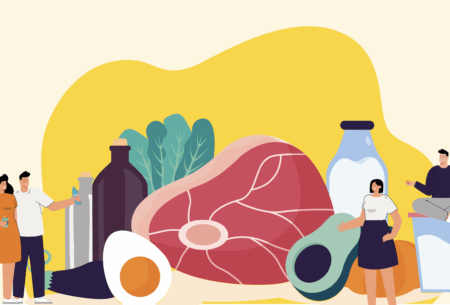You’ll no doubt have heard by now that eating high amounts of salt can increase your risk of high blood pressure (aka hypertension), which is linked with more serious problems, such as heart attack and stroke, if it’s left untreated.
Could our gut microbes play a role?
Animal studies have shown that our gut microbiota (or GM, the trillions of microbes we all have living in our gut) could be the middleman between eating too much salt and having higher blood pressure. But whether this applies to humans too and the effect of salt on our GM hasn’t really been understood.
Now, a new study (an RCT*) has found one way that salt can impact blood pressure is by affecting the way our GM produces a range of beneficial chemicals, called short-chain fatty acids (SCFAs).
Our gut microbes produce SCFAs when they break down, or ferment, various types of fibre that we eat. These SCFAs do a lot to keep us healthy, from helping to balance our blood sugars to supporting our immune system.
The findings in a nutshell
The researchers found that our salt intake may indeed influence our GM. When people with high blood pressure reduced how much salt they consumed (i.e. a reduced-salt diet), their GM produced higher levels of SCFAs, especially in women – which in turn were linked with lower blood pressure and better artery function!
Bottom line:
Reducing your salt intake can reduce blood pressure in people with hypertension and therefore improve heart health. This appears to be helped by the short-chain-fatty-acids (SCFAs) produced by our GM, at least in women.
How much salt is too much?
The recommended salt intake for adults is no more than 6g a day (2.4g sodium) – that’s around 1 tsp. But in the UK, the average intake is around 8.1g a day and in the US, on average people are eating more than 8.6g of table salt (3.4g sodium) every day.
Salt vs sodium: Salt is made up of sodium and chloride – and it’s the sodium that’s thought to have negative effects on our health.
Top tips
-
Check your food labels. 1g of sodium is 2.5g of salt, so if a food label only has one or the other, convert sodium to salt by multiplying the sodium content by 2.5. Many products in the UK will have a ‘traffic light’ label to clearly show the salt content per 100g of the food.
-
Experiment with herbs and spices. They not only boost flavour without the salt, but they also pack in more plant goodness (like polyphenols)
-
Sprinkle mixed seeds. Try swapping your salt shaker for a bottle of mixed toasted seeds to add an extra crunch, flavour and fibre to your meals.
Got more time? Read on for all the detail!
What did the study do?
First, researchers asked 145 people with high blood pressure to follow a reduced-sodium diet for two weeks (2,000 mg/day of sodium, i.e. 5,000 mg/day of salt). They were advised on how to reduce their salt intake, including not adding salt during cooking or at the table and avoiding very salty foods.
After the initial two weeks, participants were then split into two groups: one group took sodium tablets (10 mmol of sodium) to make up the ‘usual’ sodium intake, while the other group took placebo tablets (no sodium) for reduced sodium intake, 9 times a day for 6 weeks. They then switched groups.
What did they find?

The results showed that those in the reduced sodium group (taking the placebo) had increased serum levels of SCFAs, virtually all of which originated from the GM – showing that their gut microbes were responsible.
SCFAs were also linked with reduced blood pressure and better elasticity of large arteries, which is another important cardiovascular risk factor.
-
Elastic arteries (aka arterial compliance) = more storage, better able to adapt to changes in pressure.
-
Stiff arteries (aka arterial stiffness) = lower storage capacity, risk of clogged arteries
Interestingly, there was also a gender divide. When the results were analysed based on gender, the increase in SCFAs only seemed to be significant in women during the low sodium intervention, not men.
Ref: Chen, L., et al., Hypertension, 2020.
*Gut Glossary
RCT (randomized controlled trial) = a type of scientific study that reduces bias by randomly assigning people to 2 or more groups (an experimental group and a control group). That way, the only difference expected is the actual treatment, nutrient or drug (aka intervention) being studied. This makes for a high-quality study.













